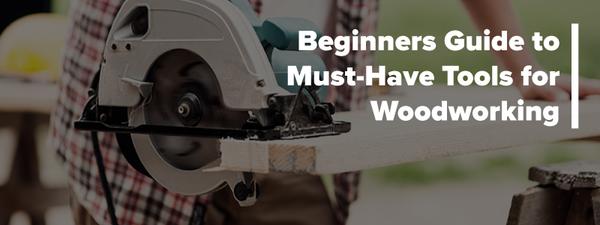
Jump to: Saws | Files, Planers, & Sanding Tools | Assembly Tools | Measurement Tools | Other Necessities
Woodworking means different things to different folks. Many woodworkers create useful and long-lasting pieces to relieve stress and exercise their creative muscles. They’re hobbyists who know sawdust is good for the soul. Others turn professional. They’re handsomely compensated for skills in building coveted furniture. But no matter if you’re a master craftsperson or a rank amateur, you need the must-have tools for woodworking. Read this entire guide for information on these tools. In short, the must-have tools for woodworking include the following:
- Hand saws
- Power saws
- Planes
- Sanders
- Files
- Hammer
- Mallet
- Drill
- Screw Gun
- Tape Measure
- Square
- Sawhorses
- Workbench
Many beginning woodworkers feel overwhelmed with the vast array of tools available on the market. It’s easy for you to rack up thousands of dollars’ worth of expensive woodworking tools in your shop. Most tools for beginner woodworkers don’t have to be elaborate and costly, though. Beginners’ woodworking tools should start with the basics so you can get the feel of simplicity that’s the core of great work.
There are five classes of basic woodworking tools. Those are tools to cut, finish, assemble, measure and hold wooden parts while transforming raw materials into completed projects. These tool groups cover everything a starting woodworker needs for building simple to complex items. To help prioritize what should go in your basic toolbox, here’s a beginner’s guide to must-have tools for woodworking.
SAWS USED FOR WOODWORKING
Almost every component in a woodworking project starts with cutting materials. The best and most interesting pieces start with rough lengths of wood. Whether that’s hardwood like oak or softwood like pine, wood stock needs ripping and crosscutting to start taking shape. Saws are the answer, but they come in different shapes and sizes. They’re also for different cutting tasks. Here’s what you need to begin building your saw collection.
Circular Saw
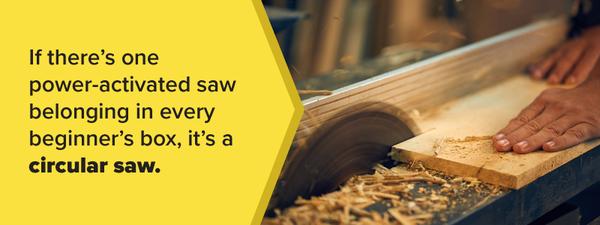
If there’s one power-activated saw belonging in every beginner’s box, it’s a circular saw. There are endless brands available, but they all have a common feature. That’s a round or circular blade full of sharp teeth that tear through wood. All circular saws are electric, although they come in various power ratings. Most are corded tools running on household current, but there have been great advances in cordless circular saws.
Some view circular saws as more ideal for rough carpentry than for fine woodworking. That’s not true at all. In the right hands, circular saws cut straight, clean lines. A lot depends on the blade you use.
Circular saw blades come in three types:
- Ripping Blades: Cut material lengthwise along or with the grain
- Crosscut Blades: For sawing across the grain
- Combination Blades: Designed for both ripping and crosscutting
The difference between blades is their teeth design. Ripping blades have evenly spaced teeth, while crosscuts have staggered ones. Combination blades have both tooth layouts. If budget is your concern, it’s best to invest in one good combination blade fitted with carbide teeth. It’s also necessary to understand blade diameters. Circular blades start at 7 ½”, though 10” blades are common, and 12” diameters are available for large dimensional woodcutting.
Circular saws are available in two distinct designs. One is a direct drive where the blade is mounted 90 degrees to the motor and directly on the arbor. Direct drives are the most common circular saw and the least expensive. Worn drive circular saws are made for heavy work. They still have the same blade designs, but the blade is gear-driven ahead of the motor.
Jigsaw
Every beginning woodworker should invest in a decent jigsaw. They’re also called saber saws because of their reciprocating, saber-like blade. These electric power tools are designed to make intricate cuts that can be straight, curved or serpentine. Think of the lines in a jigsaw puzzle, and you’ll know what a jigsaw is capable of.
Jigsaws are completely different than circular saws. Instead of revolving blades, jigsaws cut with a back and forth or up and down motion. Blades vary in tooth numbers and composition. They’re used to cut metal and plastic as well as wood. Fine-tooth blades are used for sawing veneers, while coarse tooth-blades are for rough and fast work.

Jigsaws are easily operated with one hand. That allows you to hold your work solidly with your other hand. Jigsaws nicely cut small, intricate pieces. One of the best applications for a jigsaw is interior cuts, like an inner circle or rectangle. You simply drill a pilot hole and insert the blade. With some practice, you’ll soon learn to make plunge cuts with your jigsaw.
Compound Miter Saw
Compound miter saws are a step up from regular circular saws. They still take the same rip, crosscut and combination blades as circular saws. However, they’re fixed in an arm or a track much like the radial arm saws they’ve almost replaced. Common blade diameters are 10 and 12-inch, but compound miter saws can be fitted with the smaller 7 ½” size. For a miter saw, one should always use a quality crosscut saw blade.
These electric saws are exceptionally versatile tools. They’ve replaced the standard miter box and backsaw in most shops. Beginners find that powered miter saws make far more accurate cuts for miters, bevels and compound angles. They’re easily set at standard angles like 22 ½, 45 and 90 degrees, but they can be adjusted for every angle in between. That includes left and right cuts.
Powered miter saws evolved from the standard cut-off or chop saw. Now they’re available in models with sliding arms that extend cut lengths. Their power heads also tilt to each side, allowing for a combination of miter and bevel cuts. Practically any series of angles can be cut with a compound miter saw.
Table Saw
Most beginning woodworkers invest in a table saw early in the game. Table saws produce cuts that aren’t easily achieved with other saw types. They’re designed like upside down circular saws where the blade is exposed from below the saw table or work surface. Blade depth and angles are easily adjusted for precision.
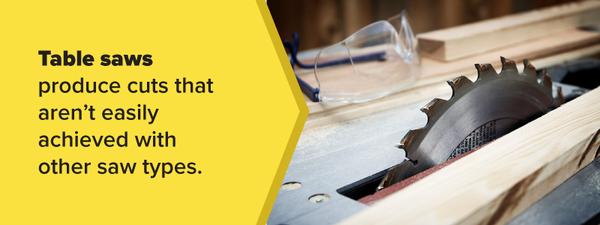
There are three main table saw versions. All three are suitable for beginning woodworkers. It depends on the size of work you’ll be doing and the location. You might want a fixed table saw that stays in one shop location or a portable saw that can be stored away. These are your table saw choices:
- Cabinet table saws are heavy and made to stay put. The name comes from their motors being enclosed in a lower cabinet with the blade driven by a belt and pulley system. They’re excellent for all-purpose work from lumber-ripping to panel-cutting. Many beginners choose a cabinet table saw as their workshop centerpiece.
- Benchtop table saws are lighter-duty. They’re made to be portable, so they’re perfect for moving between locations as well as conveniently storing when not being used. Most benchtop table saws are direct drive. That lets them remain compact, but they tend to be noisy.
- Contractor table saws are the tightest designs. Building contractors prefer them for quick and easy cutting on jobsites where time and space is a premium. Contractor table saws are also economical, making them a good choice for beginners learning their tasks.
For a table saw, also known as a chop saw or chop box, one should always use a quality blade, such as the carbide tip combination blades or rip saw blades by Luxite Saw.
Bandsaw
There’s nothing like a bandsaw for ripping rough stock or making intricate curved cuts. These power tools are a combination of circular and saber saws, where teeth are fixed on a continuously looped, flat steel band and revolve around upper and lower pulleys. A flat table is mounted between the pulleys that tilts for angled cuts.
Bandsaws come in many sizes. It depends on the size of stock you’ll be cutting and how intricate of cuts you want to make. There are two main bandsaw characteristics to be aware of, and each determines your bandsaw size choice:
- Depth capacity is how far the bandsaw blade is exposed between the pulleys. It’s also called face opening and varies between 4” for small bandsaws up to 12” or more for big machines. This determines how thick your material capacity is.
- Throat depth measures from the blade teeth to the back of the support frame. This determines how wide your stock can be. A deep throat capacity makes it easier to make curved cuts where work needs turning on the table.
Bandsaw teeth come in coarse designs for fast cuts and fine teeth for smooth, slower cutting. Blade width is important with bandsaws. Wide blades are more stable for ripping, while thin blades make curved cutting easier.
For best operating use, be sure to also invest in quality band saw tires for your bandsaw.
Handsaws
There will always be a place for handsaws in every woodworker’s shop. Handsaws are so simple and easy to use for quick work or where detailed, precision cuts are required. The nice thing about handsaws is there’s no bulky weight, clumsy cords or batteries that die. Handsaws are always ready to go, and they’re not expensive.
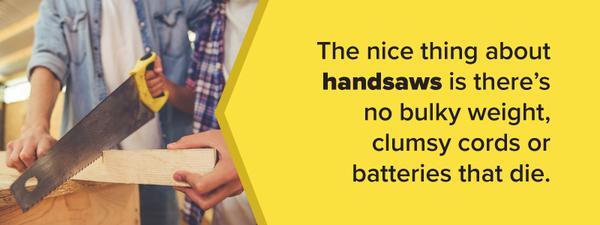
Handsaws have been around for hundreds of years. They’re basically a toothed steel blade with a wooden handle designed to slide back and forth, cutting the work. But there’s far more to handsaw application than most beginners think. Here are some handsaw designs to consider:
- Ripping Handsaws: Cut with the wood grain
- Crosscut Handsaws: Cut across the wood grain
- Combination Handsaws: Can do both rips and crosscuts
- Backsaws: Have rectangular blades with braced backs for miter cuts
- Carcase Handsaws: Larger and stronger backsaws
- Coping Handsaws: Like jigsaws and bandsaws for curved cuts
- Dovetail handsaws: For fine dovetail joint work
- Keyhole handsaws: Made to cut interior holes
Beginning woodworkers should invest in the best quality handsaws they can afford. Most frustrations with hand sawing come from cheap or dull blades. A sharp blade with excellent teeth can cut wood nearly as fast and true as an electric saw.
FILING, PLANING, AND SANDING SUPPLIES USED IN WOODWORKING
Once wood pieces are cut to a rough shape, they need more work to present an attractive, finished appearance. No matter how fine your saw blade is and how nice the quality, you’ll still need some sort of filing, planing and sanding supplies. Here’s what beginning woodworkers should consider investing in:
Planes
Planes are cutting tools rather than abrasive, sanding devices. All types of planes use a fixed blade to shave off wood fibers, letting them take shape and become progressively smoother. Blade size and depth are the key variables in how much material can be removed at a time.
You’ll hear several plane names that sound somewhat foreign, if not amusing. Rabbet planes and jack planes both shave wood, but they have considerably different applications. You’ll also hear terms like jointers, blocks and spokeshaves. As well, you’ll hear them referred to by numbers. They’re all types of hand planes that beginning woodworkers should investigate. These are the range of hand planes you might want:
- Jack Plane: These tools remove a lot of material in a pass. It’s a “jack-of-all-trades” tool because there are both curved edge and straight edge types available — for smoothing or jointing, respectively.
- Block Planes: These planes are smaller and stout. They’re best for tight work where very smooth joints are necessary.
- Joining Planes: Like jack planes, except they’re designed to smooth edges and join pieces together. Typically, jointers have long frames.
- Rabbet Planes: Used for cutting right angle grooves along board edge grain. These joints are called rabbets, which differ from inside grooves termed dadoes.
- Scraper Planes: Made to scrape fine fibers off wood surfaces for super-smooth finishes. These planes are sometimes called cabinet scrapers.
- Spokeshaves: Hand planes designed for curved surfaces. Originally, they were for wagon wheel spokes, but they found their useful way to all woodworkers.
Orbital Sander
If you’re going to buy one electric wood-finishing tool, it should be an orbital sander. These fast-action machines take all the strain out of hand sanding and do it a lot quicker. Orbital sanders differ from inline tools like belt sanders. They use sandpaper pads revolving in a circular or orbital pattern.
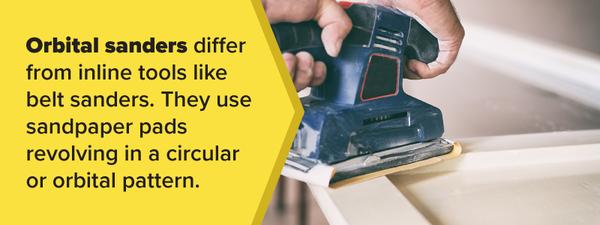
Regular orbital sanders take a circular abrasive sandpaper disk and spin it in a circle. Although they remove material fast, they tend to leave swirl marks that are hard to remove. A random orbital sander is your best buy. They don’t circulate. Rather, they oscillate in a random manner leaving the wood surface silky smooth and mark-free.
Hand Files
Often, there’s no better tool than a hand file to shape and smooth wood. Hand files are inexpensive and last a long time if you buy ones made with quality steel. Once dull, hand files are best replaced rather than trying to sharpen them. Here are your main hand file choices:
- Rasps are rough-edged tools with coarse teeth. They’re used to remove large amounts of wood for general shaping, then allow finer files to take over.
- Half-round files have a flat surface on one side and a curved face on the other. This lets them be worked on straight and curved surfaces.
- Mill files are flat on both faces. They usually have coarse teeth on one side and fine on the reverse. Mill files also have toothed edges for tight spaces.
Rotary cutters are like hand files, except they’re designed as electric drill bits. You place them in your drill chuck and let the rotary abrasive action remove material. Rotary files are available in different patterns and cutting grits.
Hand files are also used to sharpen your other woodworking blades and bits. Metal files typically have extremely fine teeth and are composed of high-grade steel. As with any tool, you usually get what you pay for, and it’s worth investing in high-grade hand files.
ASSEMBLY TOOLS FOR WOODWORKING
Cutting and smoothing wood is only part of your overall woodworking process. Once your components are properly sized and smooth enough for finishes, they still need assembling. Successful woodwork assembly depends on two things. You need precision joints that will fit. You also need the right tools to assemble and securely fasten them.

These are the basic assembly tools for beginning woodworkers:
Hammer
There’s no such thing as a universal woodworking hammer. Perhaps a carpenter’s claw hammer is as close to a one-size-does-everything pounding tool, but there are dozens of different types of them, too. Woodworking hammers are normally asked to do two tasks. That’s to pound and pry. How well they accomplish that depends on a few things:
- Head design including face size and weight. Some heads are smooth, as in finishing hammers. Some have serrated faces for gripping nails and fasteners, like you see in framing hammers.
- Claw design including length and curve. Finishing hammers have long and pronounced claws, while framing tools use a straighter edge used to split materials.
- Handle composition is critical for comfort. Most beginning woodworkers prefer a wooden or composite hammer handle. They deliver less shock when striking. Framers like steel handles. There’s more shock, but steel adds to the weight, so there’s more driving force. Steel handles also don’t break easily.
- Overall weight is important. Hammer weight is measured in ounces. Lightweight hammers are 8 to 10 ounces. Intermediate hammers are 16 to 20 ounces, while heavy-duty ones weigh 24 to 32 ounces.
Hammers vary in purpose as well as composition. Beginning woodworkers have a myriad of choices and need to identify what they’ll be using their hammers for before purchasing. These are the main types of woodworking hammers:
- Finishing hammers are all-purpose. This should be your first purchase as they’re so handy.
- Framing hammers are tough. However, they’re a bit of overkill for most woodworking projects.
- Tack hammers are like brad drivers. They’re for small work and usually have two different head sizes with no claws.
Mallet
Don’t confuse mallets with hammers. Both are striking tools, but they have entirely different applications. Hammers are usually steel-faced, but some are brass or plastic. Mallets have large wooden or leather heads and detachable handles to accommodate various head sizes.
The difference between hammers and mallets is their striking shock and surface impression. Mallets are much softer than hammers and absorb shock rather than deliver it. They also leave minimal striking marks, making mallets perfect for tapping wood joints together.
Beginning woodworkers should understand that you never, ever use a steel hammer on chisels. Shock from steel hammers causes chisels to stab or jab at the wood, leaving rough finishes. However, tapping chisels with a mallet lets them smoothly slice through wood with consistent pressure.
Power Drill
Power drills can be a beginning woodworker’s best friend. Only a few old-time craftspeople still use a brace and bit or a hand drill. Electric powered drills are used so often in the workshop and for so many reasons. They’re not only for drilling holes. You can buy all sorts of attachments to turn your electric drill into other tools, too.
If you’re buying your first power drill, seriously consider getting a corded model. Drills running on 110/120-volt currents have considerably more torque and longevity than cordless drills. Some may find cords get in the way, but they’ll never let you down with a weak charge.
If you’d rather go with cordless power drills, they are rated in voltage. Early models were 7.5-volt, but that quickly upgraded. Now, 18-volt cordless drills are a wise choice for beginners. They’re not much more expensive that 14-volt drills and have considerably more strength.
Power drills are also rated by their chuck size — 3/8” chucks are the common medium size, and heavy-duty chucks are 1/2”. Drills are available in keyed models or keyless chucks that make bit changing easier.
Screw Gun
Screws are the all-round best fasteners for woodworking. They hold tight and can be removed when disassembling, making temporary joints or when mistakes happen. You certainly don’t want to be without your standard hand screwdrivers, but investing in a powered screw gun makes driving screws faster and simpler. Screw guns are especially valuable when you have a job with multiple screws.

Screw guns are extensions of the power drill family. Most screw guns are now cordless, which makes them convenient. The main difference between a true screw gun and a power drill is the inside shape of the chuck. Screw guns are designed to insert hexagonal or six-sided bit shanks. This makes slippage non-existent.
WOODWORKING TOOLS FOR MEASUREMENT AND ANGLES
They say measure twice and cut once. That old woodworker advice is the best there is. Some other advice is to buy good quality measuring equipment that’s accurate and easy to read. Below are the main measuring and angle checking tools you need as a beginning woodworker:
Squares
It’s next to impossible to create decent woodworking projects without an assortment of squares. Good squares let you create and verify all sorts of angles. Most squares also have measuring markings engraved on their surface. This lets them double as measuring rules. These are the squares you should have:
- Framing Squares: Large, right angle tools for bigger work surfaces
- Try Squares: Smaller, right angle hand devices for quickly verifying squareness
- Combination Squares: Used for precise checking of angles and distances
- Speed Squares: Quickly let you check 90 and 45-degree angles
- Miter Squares: Best for setting angled miter cuts
- Bevel Squares: Allow you to recreate an existing angle and transfer patterns
Dividers, compasses and depth gauges aren’t technically squares, but they’re simple and invaluable woodworking tools. They cross into the other family of measuring tapes and rules.
Tape Measures
Every woodworker should have at least one tape measure hooked on their belt.

It’d be hard to have all tape measures attached to you, though, because there are so many types. Here are the basic tape measures to consider:
- Retractable Steel Tapes: These are the most common measuring tools. They come in lengths from 12 to 30 feet.
- Flexible Reel Tapes: You can get them in fabric or steel in lengths over 100 feet.
- Folding Rules: Notice they’re not called rulers. These are rigid measuring sticks for high accuracy. Most rules fold into multiple sections.
- Yardsticks and Straight Edges: These are in the ruler family and are handy for quick takeoffs and laying straight lines.
Other Necessities for Successful Woodworking Projects
Now that you’ve got an idea about what beginning tools you need for cutting, finishing, assembling and measuring woodwork projects, you’ll need a way to hold them while underway. Clamping devices are indispensable in woodworking shops. The two best holding tools are sawhorses and your quality work bench:
Sawhorses
Sawhorses are one of the first investments you should make as a woodworker. They’re simple four-legged creatures that nicely balance and support long lumber lengths and heavy weights. Sawhorses are usually used in pairs, but many woodworkers have half a dozen sawhorses around.
You can make your own rigid sawhorses out of wood. That’s an economical way to use up scrap materials. But there are so many commercial sawhorses available that are made from steel, fiberglass and plastic. It might not be worth your time to manufacture sawhorses unless you want the practice.
Quality Work Bench
If there’s one real expense to consider as a beginning woodworker, it’s to invest in a quality workbench.
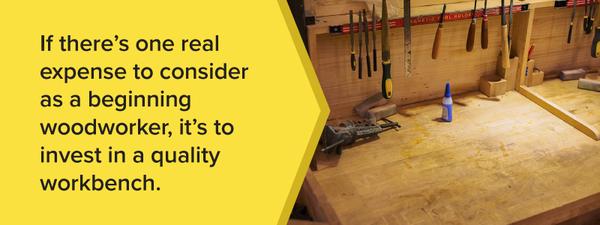
Yes, you can make your own out of 2x4s and plywood, but you’re never going to get the usefulness you’ll get with a professional grade, quality workbench. You’ll use it for every project and all the time. Here are features to look for in a quality workbench:
- Solid, hardwood construction
- Adjustable base for accurate leveling
- Two various sized vices
- Large working surface with built-in stops
- Lower drawers for storing tools
- Free-standing with 360-degree access
Invest in Quality Woodworking Tools
One last beginning woodworker tip to leave you with is investing in quality tools. That’s what Luxite Saw’s products are all about.
Our bandsaw tires and saw blades are backed by five-star reviews. All of our products are made proudly in the USA and our blades are manufactured in-house by our team of blade specialists. Our blades cost slightly more than a typical miter or table saw blade, but craftsmen swear by their durability and resistance to wear.
Updated 10/28/2021

